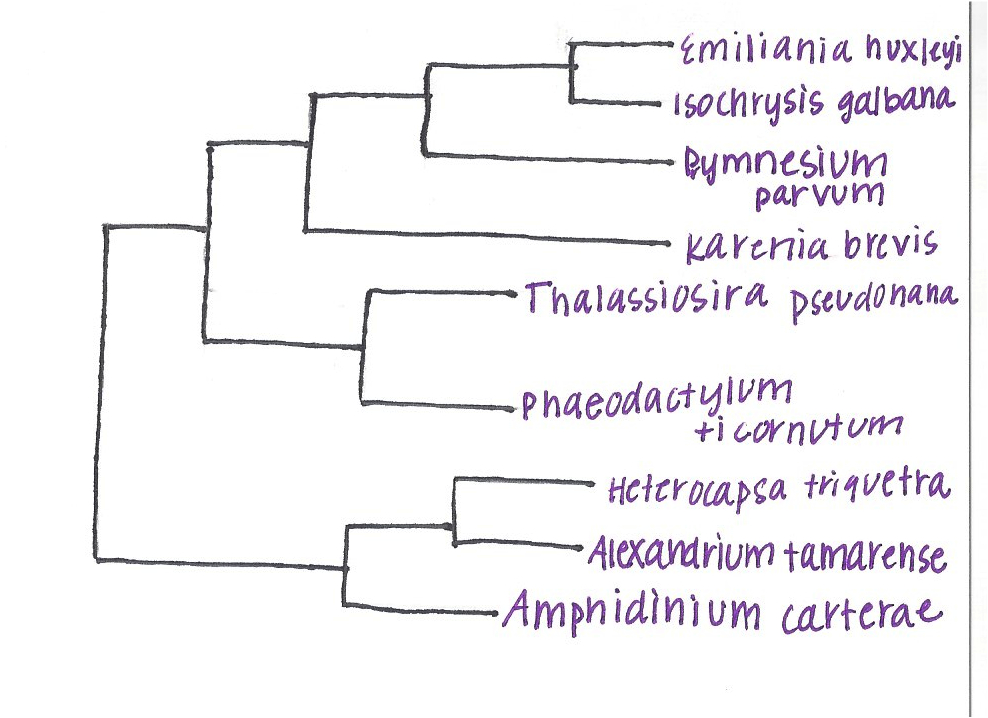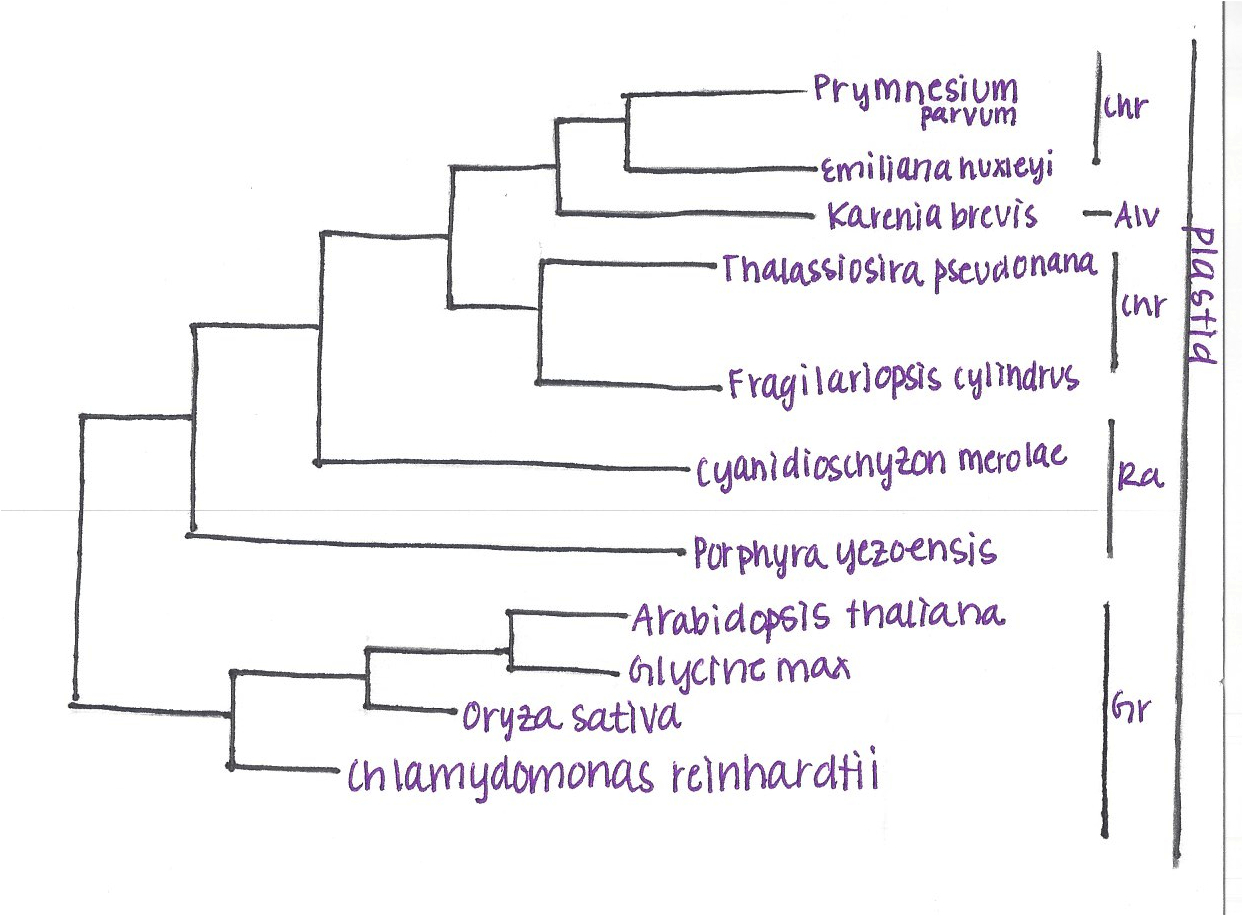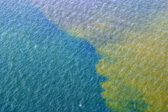Classification
The taxonomy, or classification, of Karenia brevis changes as advances in technology are made. Karenia brevis was first named Gymnodinium brevis in 1948, but later changed to Gymnodinium breve, which correlates with the guidelines of the International Code of Botanical Nomenclature. In 1979 it was categorized under the genus Ptychodiscus and named Ptychodiscus brevis as new research showed it fit better under this genus because of its morphology, biochemistry, and ultrastructure. Then, in 1989, scientists agreed this organism should be referred to as its original name (G. breve). It was then reclassified and transferred to the new genus Karenia which was established at the University of Copenhagen in 2000. Therefore Karenia brevis = Ptychodiscus brevis = Gymnodinium breve. Below is the most recent classification for this organism.
| Domain | Eukarya |
| Kingdom | Protoza |
| Phylum | Dinophyta |
| Class | Dinophyceae |
| Order | Gymnodiniales |
| Family | Kareniaceae |
| Genus | Karenia |
| Species | Karenia brevis |
Domain:
Karenia brevis falls under the domain
Eukarya as it has eukaryotic cells with membrane
bound organelles, like mitochondria. This domain is
comprised of cells that contain a true nucleus and
no cell wall. Prokaryotes are set apart from these
organelles as they do not have a true nucleus. Check
out these organisms to better understand how broad
this domain is. Some examples of eukaryotic
organisms are
Curcuma Longa L.,
Passiflora edulis,
Papaver somniferum,
Chlamydosaurus kingii,
Giraffa camelopardalis,
Bos taurus,
Carychium exiguum,
Vertigo gouldii,
Actinidia deliciosa,
Anethum graveolens, and
Pagophilus groenlandicus.
Kingdom:
Karenia brevis is categorized under the kingdom
protozoa because it is a single celled eukaryote.
Protozoa commonly have characteristics associated
with animals like mobility and heterotrophy. This
group is often grouped together with plant-like
algae and slime molds. Protozoa are too small to be
seen with the naked eye, but can be easily seen
under a microscope.
I also found mixed information on Karenia brevis and what kingdom it could be classified under. I found it classified under kingdom chromista which entails colored, photosynthetic organisms that have chlorophyll c, but are not related to the plants and algae. Because kingdom chromista does not include algae, this is not the correct classification and as more research has been done, we now know this organism belongs to kingdom protozoa.

This is a plastid
phylogeny using genes implicated in tertiary EGT in
Karenia brevis. Photo drawn by author. Adapted from
the hyperlinked page.
Phylum:
Dinophyta posses cellulose plates; they are
unicellular, and most utilize two flagella. This
phylum can also be autotrophic or heterotrophic and
they are primary producers in marine systems. Since
Karenia brevis is a primary producer in its
marine system and can produce harmful toxins, this
leads to more problems.
Class:
Karenia brevis belongs to the class dinophyceae as
these organisms are unicellular and are free living,
symbiotic, or parasitic organisms with a nucleus
that have a large number of banded chromosomes. This
group also utilizes its motile stage having two
dissimilar flagella. An example of an organism from
this class is
Gonyaulax catenella.
Order:
This order classification has unarmored kinokont
like cells that have lingulum and culcus. They have
thecal vessels without thecal plates. Organisms in
this class may be osmophlilic material with or
without chloroplast. These organisms have
nematocysts,
ocelli or siliceous as internal structures.

This is a maximum likelihood
phylogenetic tree based off of plastid and
mitochondria-targeted translation. Photo drawn by
author. Adapted from the hyperlinked page
Family:
The family Karenia brevis belongs to can
produce toxins like brevetoxins (the one K.
brevis produces) and gymnodimines, among others.
This family is associated with harmful algal blooms
and can cause marine animal illness and mortality.
Family Kareniaceae is considered to be harmful.
Genus:
Genus Karenia is an unarmored dinoflagellate. This
genus is found throughout the world, but usually in
sparse abundance unless they are blooming. This
genus is toxic and can be found in costal and
oceanic water.
Species:
Karenia brevis final classification is
given for its short blooms. "Brevis" in English
means short, hence the short blooms as its name and
this species can also be toxic.
Find out what this toxic organisms' habitat is like or you can go home.
